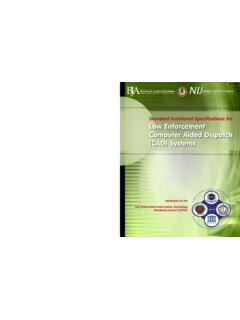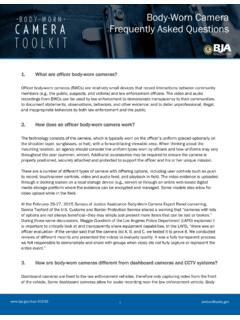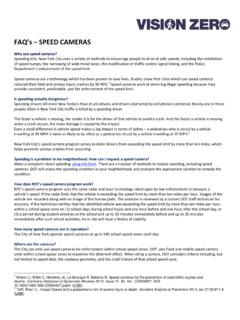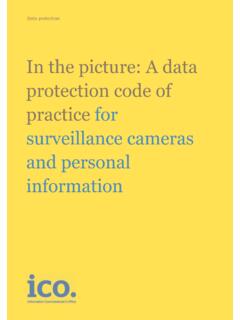Transcription of Police Officer Body-Worn Cameras
1 Police Officer Body-Worn Cameras Assessing the evidenceby Michael D. White, PhDPolice Officer Body-Worn Cameras Assessing the evidenceby Michael D. White, PhDThis project was supported by Contract No. GS-23F-9755H awarded to Booz Allen Hamilton and its partners, the Institute for Intergovernmental Research and Center for Naval Analyses, by the Office of Justice Programs, Department of Justice. Points of view or opinions in this document are those of the author and do not necessarily represent the official position or policies of the Department of publication contains proprietary information and shall not be used, disclosed, or reproduced, in whole or in any part, for any purpose other than to review and use for internal purposes without prior written consent.
2 Correspondence concerning this publication should be addressed to either Michael D. White (Phone: 602-496-2351, or the Diagnostic Center, Office of Justice Programs, 810 Seventh Street, NW, Washington, DC 20531 (855-657-0411, Recommended citation: White, Michael D. 2014. Police Officer Body-Worn Cameras : Assessing the Evidence. Washington, DC: Office of Community Oriented Policing obtain additional copies of this publication, visit the COPS Office online at 2014e041425643 Police Officer Body-Worn Cameras : Assessing the Evidence1 Contents Letter from the Assistant Attorney General.))
3 3 Executive Summary .. 5 Resources and research .. 5 Perceived benefits and concerns .. 6 Recommendations .. 10 Introduction .. 11 Resources and Research .. 15A brief note on methodology .. 15 Studies in the United Kingdom .. 16 Studies in the United States .. 17 Perceived benefits and concerns .. 18 The Perceived Benefits of Officer Body-Worn Cameras .. 19 Increased transparency and Police legitimacy .. 19 Improved Police Officer behavior .. 20 Improved citizen behavior .. 22 Expedited resolution of citizen complaints/lawsuits.
4 23 Evidence for arrest and prosecution .. 24 Opportunities for Police training .. 25 Concerns and Considerations Regarding Body-Worn Cameras .. 27 Concerns for citizens privacy .. 27 Concerns for officers privacy .. 28 Concerns for officers health and safety .. 29 Investments in training and policy .. 30 Substantial financial, resource, and logistical commitment .. 322 Police Officer Body-Worn Cameras : Assessing the EvidenceConclusion and Recommendations .. 35 Civilizing effect .. 35 Evidentiary benefits .. 36 Impact on law enforcement agencies and other stakeholders.
5 36 Recommendations .. 37 References .. 38 Appendix A. Useful Guides to Body-Worn camera Technology .. 41 Appendix B. Body-Worn camera Policy Template .. 43 About the Author .. 54 Table 1. Empirical studies of Officer Body-Worn Cameras as of September 2013 .. 16 Table 2. Perceived benefits and concerns with Officer Body-Worn Cameras .. 18 Police Officer Body-Worn Cameras : Assessing the Evidence3 Letter from the Assistant Attorney GeneralDear colleagues,I am pleased to bring you this resource from the Office of Justice Programs (OJP) Diagnostic Center on Body-Worn video Cameras .
6 This review was produced for a Diagnostic Center client seeking to understand the costs and benefits to the law enforcement community to use body- worn camera technology, and we believe the information assembled by the Diagnostic Center can be of use to law enforcement departments throughout the you may know, OJP is committed to translating scientific evidence about what works in criminal justice and public safety to the field, ensuring it is both accessible and user friendly. OJP launched the Diagnostic Center in spring 2012 to facilitate this translation process of science into outcomes.
7 The Diagnostic Center is a technical assistance resource for state, local, and tribal policymakers seeking to implement data-driven strategies to combat crime and improve public pursuing that mission, the Diagnostic Center undertook this literature review of the current evidence on the challenges and benefits of Body-Worn video camera technology. I hope that this resource, which we are proud to be publishing jointly with our colleagues from the Office of Community Oriented Policing Services (COPS Office), helps inform your department s con- versations about the use of Body-Worn video Cameras in the field.
8 If you are interested in receiving services from the OJP Diagnostic Center, please visit or call 1-855-657-0411 to learn more about how the Diagnostic Center engages with client communities to improve public ,Karol V. Mason Assistant Attorney General Office of Justice Programs Police Officer Body-Worn Cameras : Assessing the Evidence5 Executive SummaryIn recent years, technological innovation has continually shaped law enforcement, from less-lethal devices ( , TASER) and forensic evidence to advanced crime analysis. The most recent technologi-cal innovation that may redefine policing is Officer Body-Worn camera systems.
9 The technology has received considerable attention in the media and among policing officials. For example, in her August 2013 ruling that declared the New York Police Department s (NYPD) stop, question, and frisk program unconstitutional, Judge Shira Scheindlin included Body-Worn Cameras as part of the judicial order. On September 11, 2013, the Police Executive Research Forum (PERF) held a conference on the technology. Although advocates and critics have made numerous claims regarding Body-Worn Cameras , there have been few balanced discussions of the benefits and problems associated with the technology and even fewer discussions of the empirical evidence supporting or refuting those publication provides a review of the available evidence on Officer Body-Worn Cameras .
10 The goal is to provide a comprehensive resource that will help law enforcement agencies to understand the factors they should consider to make informed decisions regarding the adoption of Body-Worn camera technology. Resources and researchThis publication reviews several available resources that offer a starting point for exploring the Body-Worn camera technology (see Appendix A for greater detail): The UK Home Office s Guidance for the Police Use of Body-Worn Video Devices (Goodall 2007) The National Institute of Justice s (NIJ) A Primer on Body-Worn Cameras for Law Enforcement (ManTech 2012) Body Worn Video Steering Group, resource also provides an overview of empirical studies to date that have examined the implementation and impact of Officer Body-Worn Cameras .














